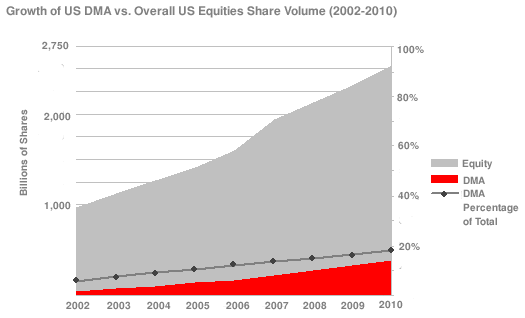The Evolution of Direct Market Access (DMA) Trading Services in the US and Europe
Abstract
The Evolution of Direct Market Access (DMA) Trading Services in the US and Europe
For the past decade, electronic trading has been the dominant trend on both sides of the Atlantic. Following rapid developments in automation, direct market access has transformed the equities trading landscape.
Direct market access (DMA) is utilized by many hedge funds to facilitate complex algorithmic strategies. Through direct connectivity to market venues, DMA allows faster and cheaper trading so that firms can focus on creative strategies to extract greater alpha and return. Growth of DMA can be attributed to developments on the buy side and regulatory implementations. As the most frequent and most aggressive users of DMA, hedge funds play a large role in encouraging greater rates of DMA in the US and Europe. With the growth of the hedge fund industry and the greater adoption of statistical arbitrage strategies, better execution standards combined with low-touch trading will become a necessity.
In a new report, The Evolution of Direct Market Access (DMA) Trading Services in the US and Europe, Celent examines DMA across the US and Europe including growth, pricing, market share, and market leaders in both regions. DMA market models and evolution are also addressed, as well as growth drivers contributing to DMA success.
Celent estimates the US market for DMA to be 15-18% of equities share volume. DMA flow is predicted to increase to 20% of equities share volume by 2010, gradually replacing manual executions. In Europe, DMA flow for equities is expected to grow from 8% of traded value to 15% in 2011. The demand for greater venue aggregation to cope with the proliferation of alternative trading systems (ATSs) and multilateral trading facilities (MTFs) and the need for faster execution and compliance in response to MiFID regulations are expected to contribute to DMA growth in Europe.

"The long and short of it all is that DMA makes trading cheaper and faster and is a growing option for traders. Moreover, it puts positive pressure on exchanges and other liquidity venues to improve their technological standards and execution quality in order to stay in line with DMA developments," says David Easthope, senior analyst with Celent's Securities & Investments group and co-author of the report.
DMA's attractiveness as a toolset for the buy side should not be minimized. "As raw material for more complex add-ons like algorithms and smart order routing, DMA should continue to see increased demand in this electronic trading age," says Chermaine Lee, analyst with Celent's Securities & Investments group and co-author of the report.
This 31-page report contains eight figures and 11 tables. A table of contents is available online.
Members of Celent's Institutional Securities & Investments research service can download the report electronically by clicking on the icon to the left. Non-members should contact info@celent.com for more information.

